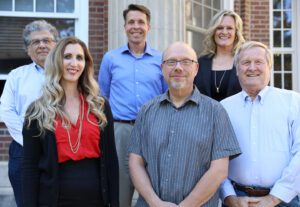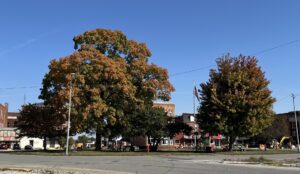A day that Monmouth College physics professor Mike Solontoi has been anxiously awaiting for years became reality on June 23, when the first images from the 8.4-meter Legacy Survey of Space and Time telescope at the Vera C. Rubin Observatory in Chile were released.
Media around the world covered the event, which he said was a teaser of what the survey is going to do for the entire sky.
“The feedback has been really positive,” added Solontoi, who has worked on the Rubin team for two decades, pre-dating his time on Monmouth’s faculty. “A number of my friends have let me know they’ve heard about it, and my wife said the daily BBC podcast she listens to was talking about it. My phone’s news aggregator knows I’m interested in such stories, and I’m seeing them from everywhere – CNN, AP, The Times of India.”
Headlines include “Rubin Observatory’s First Images Are Stunning” and “Millions of New Asteroids: How The Vera Rubin Telescope Changes Everything.”
‘A discovery engine’
Solontoi said the telescope will serve as “a discovery engine.” When interviewed about the project in the spring of 2023, he said, “It will be similar from going to a Victorian-era map of the world to Google Maps.” The professor’s specialty is the Solar System, where there are roughly one million known asteroids. He said that in the first two years of the project, that number is expected to reach six million. It’s only been a few days, and the discoveries are already starting to mount.
“The first image asteroid data from Rubin discovered around 2,100 new asteroids, including seven Near Earth Asteroids, just from one image,” said Solontoi. “For the Near Earth Asteroids found, they could be as small as 35 meters to as large as 300 meters in diameter depending on how reflective they really are. That’s a bit bigger than a basketball court at the small end, and about three football fields at the large end.”
Further from Earth in the main belt of asteroids between Mars and Jupiter, the sizes should be around one kilometer across, noted Solontoi, who said there’s no imminent danger from the discoveries.
“No, no, no, no,” said Solontoi, who co-authored a paper about the project that was published in the Astrophysical Journal Supplementary Series. “It’s just good to have a complete census of things that might bump into us. But no, astronomers are terrible at keeping secrets. There’s no conspiracy theory.”
But just in case, Solontoi will oversee a group of Monmouth students participating in a three-week SOFIA project before the start of fall classes. They’ll be focused on what he called “planetary defense.”
Worth the wait
When Solontoi was working on the dissertation for his Ph.D. at the University of Washington, he remembers changing the date in his text about Rubin’s “first light” from 2014 to 2015. But neither wound up being the case, nor was his understanding in 2023 that first light would come the following year.
But Rubin’s first light now has the green light, and a universe of wonder awaits. The project will produce a “10-year digital movie of the sky,” said Solontoi. “It’s the only project like it in the world.”
The Rubin Observatory is located in the Andes on the top of Cerro Pachon in Chile, a region that is favored for astronomical observations because it affords dry air and dark skies.
“Chile is incredibly dedicated to astronomy,” said Solontoi, noting that interest dates back scores of centuries. “Thousands of years ago, the sky was your calendar, your scheduler.”
National Science Foundation Chief of Staff Brian Stone said the project “will capture more information about our universe than all optical telescopes throughout history combined.” Over the next decade, the observatory is expected to track more than 20 billion galaxies.
The project has four main goals: understanding dark matter and dark energy, exploring the changing sky (transient and variable objects), mapping the Milky Way and creating an inventory of the Solar System. Like the rest of us, Solontoi looks forward to what astronomers will learn about the first three, even as his main focus is the Solar System where, in addition to all the new asteroids, trans-Neptunian objects will be part of the discovery process.
“A ninth planet – a proper planet – could be discovered,” said Solontoi of the quest to find an object that replaces Pluto – the largest TNO, now known as a dwarf planet – in the No. 9 spot in the Solar System. “There’s a lot of theory and doubt, but it’s testable – either it’s there, or it isn’t. Within the first two years, we’ll know.”
Research opportunities
In addition to working with SOFIA students, Solontoi oversaw the research of 2024 graduate Tori Cook, who produced a poster titled “Expected Long Period Comet Observations with the Vera C. Rubin Observatory.”
“The nice thing is, as an institution in either the U.S. or Chile, we have the data rights,” said Solontoi, who will devote his sabbatical next spring to Rubin-related work, including writing tutorials for undergraduates and devising guided research projects. “If a Monmouth student wants to work on this, all they have to do is talk to me. And I’ll say, ‘Let’s enable you to do your own science here.'”
You don’t have to be a Monmouth College student to get in on the fun. Solontoi said people around the world are already enjoying a “sonification” of the night sky. A method of representing data through sound, sonification has been used to match sounds with the color of the stars. “People are already playing with this,” he said. “It’s like listening to a well-tuned wind chime.”
A link to what Solontoi called “amazing pictures and movies” from the Rubin Observatory is available at https://rubinobservatory.org/gallery/collections/first-look-gallery.
***Courtesy of Barry McNamara, Monmouth College***








